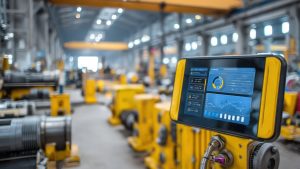Maintenance management has long been a challenging task. Deciphering handwritten notes and complex reports used to be the norm. But now, NLP shapes maintenance management through its ability to transform complex data into actionable insights. By analyzing protection logs, painting orders, and reports, NLP streamlines techniques, enhances performance, and increases uptime. This generation empowers upkeep teams to transport from reactive to proactive strategies, making operations extra productive, facts-driven, and responsive to enterprise desires.
NLP allows us to understand the needs of our equipment without specialized knowledge. This saves valuable resources and improves decision-making. It also offers a bright future for optimized maintenance processes.
Table Of Contents:
- What is NLP and Why Should Maintenance Managers Care?
- How NLP is Shaping Maintenance Management
- Real-world Examples: How Companies Use NLP in Maintenance
- Challenges in Adopting NLP and Future Directions
- Conclusion
What is NLP and Why Should Maintenance Managers Care?
NLP empowers computers to comprehend human language. It grants machines the ability to read, interpret, and analyze text data, just like humans. In maintenance, this transforms technician notes, work orders, and sensor data into actionable insights. This revolutionizes our interaction with maintenance information.
How NLP Works in Maintenance
NLP sifts through vast amounts of text, identifying patterns and correlations that humans might overlook. It can link seemingly unrelated events. For example, NLP analyzes maintenance logs to detect recurring equipment issues and predict future failures. This allows for proactive maintenance and minimizes disruptions, enabling timely interventions based on data-driven predictions, as highlighted by Terotam’s explanation of natural language processing. Ultimately, this leads to more efficient maintenance activities.
How NLP is Shaping Maintenance Management
NLP is reshaping the maintenance management landscape by boosting efficiency in various areas, from maintenance requests and predictive maintenance to supply chain optimization. These NLP applications, coupled with artificial intelligence, provide valuable tools for facility management.
Predictive Maintenance
Predictive maintenance involves intervening with equipment repairs at the optimal time. This balances maximizing equipment lifespan with ensuring equipment availability. It helps facility managers use available maintenance data efficiently.
NLP plays a crucial role in predicting necessary repairs and associated costs. Using historical maintenance records and real-time sensor data, NLP can forecast potential failures. This allows for proactive maintenance and minimizes costly surprises. A 2016 study in the Journal of Performance of Constructed Facilities explored the use of common knowledge in facility maintenance.
With predictive maintenance powered by NLP, maintenance teams can optimize planned downtime. This prevents unexpected breakdowns and ensures smooth operations. Recurrent neural networks and other learning models can analyze time series data to further improve predictions.
Automating Documentation
NLP automates tedious maintenance reports and work orders. This frees up technicians to focus on repairs instead of paperwork. This reduces manual interventions and improves overall productivity. NLP also improves data quality and eliminates errors associated with manual data entry.
NLP algorithms process unstructured text from work requests, creating structured electronic work orders. This allows managers to track maintenance activities and optimize resource allocation. Research published in Automation in Construction highlights the benefits of digitization in facility management.
Streamlining Work Orders
NLP enables automated work order processing. The system interprets maintenance requests, identifies the problem, and assigns the appropriate technician. This streamlines workflow and accelerates repairs, reducing downtime and improving operational efficiency.
NLP helps prioritize issues based on urgency. This ensures that critical repairs are addressed promptly, further optimizing maintenance operations and improving decision making within facility management.
Real-time Decisions
NLP provides maintenance managers with up-to-the-minute information. This allows for timely, informed decisions. By being proactive instead of reactive, managers can prevent problems before they escalate.
Real-time data empowers maintenance managers to make informed choices about resource allocation, maintenance scheduling, and inventory control. This enhanced decision making leads to improved operational efficiency and reduced costs. For new maintenance managers looking for best practice check out tips here.
Better Inventory Control
NLP helps prevent stockouts of spare parts. By analyzing repair histories, NLP predicts which items are likely to be needed, ensuring that inventory levels are optimized. This reduces delays caused by missing parts and improves maintenance responsiveness.
NLP’s data analysis capabilities extend to inventory management. It enables more accurate demand forecasting and streamlines procurement processes. This ensures the availability of necessary parts for maintenance activities.
Real-world Examples: How Companies Use NLP in Maintenance
Many companies are leveraging NLP to improve their maintenance processes. One example involves a manufacturing plant whose technicians struggled with inaccurate report classifications. Their work requests weren’t properly prioritized because drop-down menus lacked essential information. An NLP-powered system helped fill in missing metadata, streamlining their workflow and optimizing resource allocation.
Another example involves using sentiment analysis of technician notes to understand overall employee sentiment. This helped management make operational changes to increase morale and worker satisfaction which drastically improved work quality.
Challenges in Adopting NLP and Future Directions
Implementing NLP can present challenges. Training technicians on new technology is essential for successful adoption. Older facilities and complex industries might encounter difficulties integrating NLP solutions into existing systems. Data collection and preparation for NLP models can also be challenging, especially for organizations with large, unstructured datasets. Extracting insights from this data requires careful data analysis and processing.
The Road Ahead
The future of NLP includes self-learning systems. These systems will guide technicians through step-by-step repair procedures, acting as intelligent digital manuals. AI and machine learning will play an increasingly significant role. As discussed in this article on AI in maintenance, NLP is a crucial component of AI-driven maintenance practices, enhancing fault detection and diagnostics. This improves safety in complex, high-risk maintenance tasks and paves the way for more sophisticated maintenance management systems.
Conclusion
NLP is revolutionizing maintenance management by integrating advanced technologies such as deep learning and condition monitoring to optimize processes, boost efficiency, and empower maintenance teams across various industries. This technology shifts maintenance strategies from reactive repairs to proactive prevention, enhancing operational reliability and reducing unexpected downtime.
By leveraging natural language capabilities, businesses can extract valuable insights from maintenance requests, social media interactions, and work orders—enabling data-driven decisions that save resources, improve productivity, and foster a safer work environment.
In industries like building maintenance, NLP helps organizations predict equipment failures, streamline workflows, and enhance communication between technicians, even across language barriers. With machine translation and semantic analysis, global maintenance collaboration becomes more efficient, improving knowledge sharing and extending the equipment life cycle.
As maintenance management continues to evolve, NLP-driven solutions will play a critical role in shaping the future, ensuring businesses stay competitive and prepared for ongoing operational challenges.



